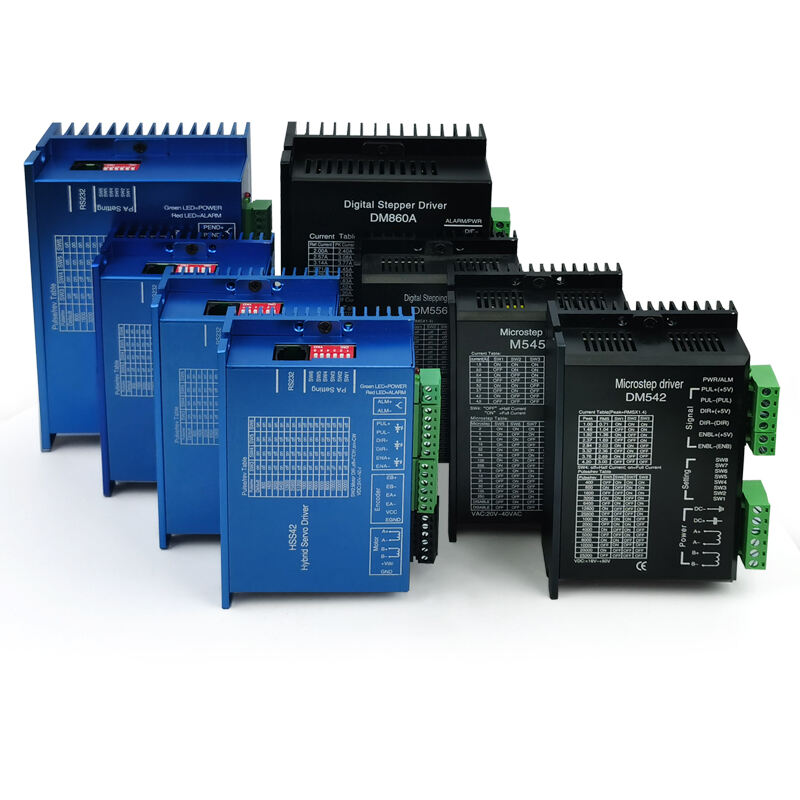Understanding the Evolution of Stepper Motor Control Systems
The world of motion control has witnessed remarkable advancements in recent years, particularly in how we approach stepper motor control. Traditional open-loop stepper systems have served industries well for decades, but the integration of closed-loop feedback is revolutionizing precision and reliability in motor applications. As automation demands become increasingly sophisticated, many engineers and system designers are questioning whether the additional investment in closed-loop feedback technology truly delivers value beyond conventional stepper motor drivers.
The decision to implement closed-loop feedback in stepper motor systems represents a significant shift in control philosophy. While standard stepper drivers operate on predetermined commands without position verification, closed-loop systems continuously monitor and adjust motor performance in real-time. This fundamental difference has far-reaching implications for system reliability, accuracy, and overall performance.
Fundamental Benefits of Closed-Loop Feedback Integration
Enhanced Position Accuracy and Verification
When implementing closed-loop feedback in stepper motor systems, one of the most immediate benefits is the dramatic improvement in position accuracy. The system constantly monitors the actual position of the motor shaft and compares it to the commanded position. This real-time verification ensures that any discrepancy between the intended and actual position is promptly corrected, maintaining precise positioning even under varying load conditions.
The ability to verify position continuously also provides valuable diagnostic information about system performance. Engineers can monitor positioning errors, track system behavior over time, and identify potential issues before they lead to failures. This predictive capability is particularly valuable in critical applications where positioning accuracy directly impacts product quality or process efficiency.
Torque Optimization and Energy Efficiency
Closed-loop feedback systems excel at optimizing motor torque based on actual load requirements. Unlike standard stepper drivers that must always operate at maximum current to ensure adequate torque, closed-loop systems can dynamically adjust current levels. This intelligent torque management leads to significant energy savings and reduced heat generation, ultimately extending motor life and improving system reliability.
The energy efficiency gains become particularly apparent in applications with variable loads or frequent start-stop cycles. By delivering only the necessary torque at any given moment, closed-loop systems can reduce power consumption by up to 50% compared to traditional open-loop configurations.

Performance Advantages in Dynamic Applications
Superior Stall Detection and Recovery
One of the most compelling arguments for incorporating closed-loop feedback is its ability to detect and respond to motor stalls. In traditional open-loop systems, a stalled motor goes undetected, potentially leading to missed steps and accumulated positioning errors. Closed-loop feedback immediately identifies stall conditions, allowing the system to take corrective action or alert operators to potential problems.
This capability is particularly valuable in high-speed or high-load applications where the risk of motor stalling is increased. The system can automatically adjust operating parameters or initiate recovery procedures, maintaining production continuity and preventing damage to expensive equipment or materials.
Improved Dynamic Response and Speed Control
Closed-loop feedback enables stepper motors to operate at higher speeds while maintaining accuracy and stability. The system can optimize acceleration and deceleration profiles based on actual load conditions, resulting in smoother motion and reduced vibration. This enhanced dynamic performance opens up new applications for stepper motors in areas traditionally dominated by more expensive servo systems.
The ability to maintain precise speed control across varying loads also contributes to improved process consistency and product quality. Applications requiring precise synchronization between multiple axes particularly benefit from the enhanced speed control capabilities of closed-loop systems.
Economic Considerations and Return on Investment
Initial Cost Analysis
While closed-loop feedback components add to the initial system cost, the long-term economic benefits often justify the investment. The additional expenses typically include encoders, feedback processing electronics, and potentially more sophisticated motor drivers. However, these costs should be weighed against the potential savings in energy consumption, maintenance requirements, and improved production efficiency.
Many manufacturers find that the reduced downtime and increased throughput enabled by closed-loop feedback systems result in payback periods of less than a year. The ability to operate motors more efficiently also leads to reduced cooling requirements and lower operational costs.
Long-term Value and System Reliability
The implementation of closed-loop feedback significantly enhances system reliability and reduces maintenance requirements. The ability to detect and prevent stall conditions extends motor life, while the optimization of torque reduces wear on mechanical components. These reliability improvements translate directly into reduced maintenance costs and increased production uptime.
Furthermore, the diagnostic capabilities of closed-loop systems enable predictive maintenance strategies, allowing organizations to schedule maintenance activities based on actual system performance rather than fixed time intervals. This approach optimizes maintenance resources and prevents unexpected failures.
Implementation Considerations and Best Practices
System Integration Requirements
Successfully implementing closed-loop feedback requires careful consideration of several factors, including encoder selection, driver compatibility, and control system integration. The choice of feedback device must match the application's resolution requirements and environmental conditions. Additionally, the control system must be capable of processing feedback signals and implementing the necessary correction algorithms.
System designers should also consider the impact on existing control software and operator training requirements. While modern closed-loop systems are increasingly user-friendly, some level of additional training may be necessary to fully utilize the advanced features and diagnostics available.
Application-Specific Optimization
The benefits of closed-loop feedback can be maximized through careful optimization for specific applications. This includes tuning control parameters, setting appropriate error thresholds, and configuring recovery procedures. The system should be configured to balance positioning accuracy with system stability and response time based on application requirements.
Regular monitoring and adjustment of system parameters ensure optimal performance as conditions change over time. This ongoing optimization process helps maintain the highest levels of efficiency and reliability throughout the system's operational life.
Frequently Asked Questions
How does closed-loop feedback affect motor temperature and efficiency?
Closed-loop feedback systems typically reduce motor operating temperature by optimizing current delivery based on actual load requirements. This results in improved energy efficiency and extended motor life compared to traditional open-loop systems. Temperature reductions of 20-40% are common in many applications.
What types of applications benefit most from closed-loop feedback?
Applications requiring high precision, variable loads, or operation at high speeds benefit most from closed-loop feedback. This includes CNC machinery, packaging equipment, semiconductor manufacturing, and any process where position accuracy and reliability are critical to product quality or process efficiency.
Can closed-loop feedback be added to existing stepper motor systems?
Many existing stepper motor systems can be upgraded to include closed-loop feedback, though the specific requirements depend on the current system configuration. The upgrade typically involves adding an encoder, replacing or modifying the motor driver, and potentially updating the control system software.
What maintenance requirements are associated with closed-loop feedback systems?
Closed-loop feedback systems generally require minimal additional maintenance compared to open-loop systems. Regular inspection of encoder connections and occasional recalibration may be necessary, but the diagnostic capabilities often reduce overall maintenance requirements by enabling predictive maintenance strategies.

